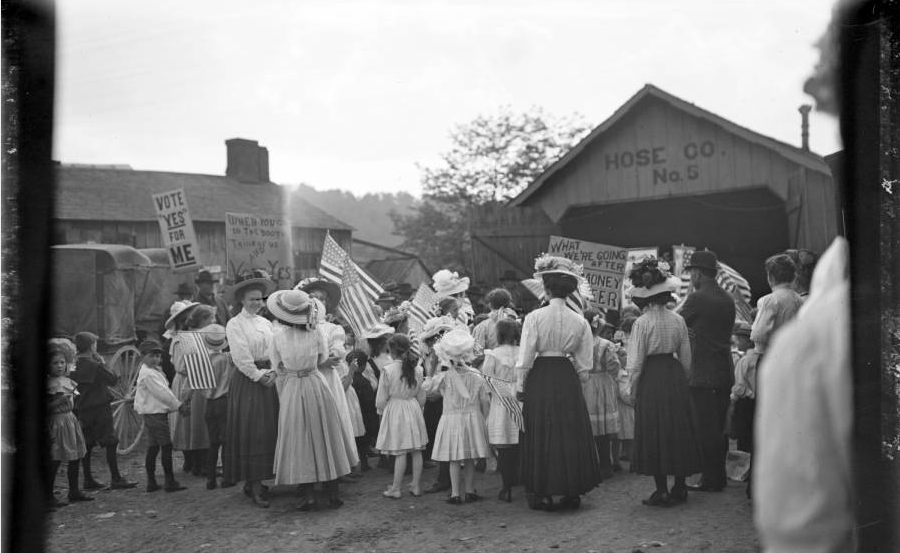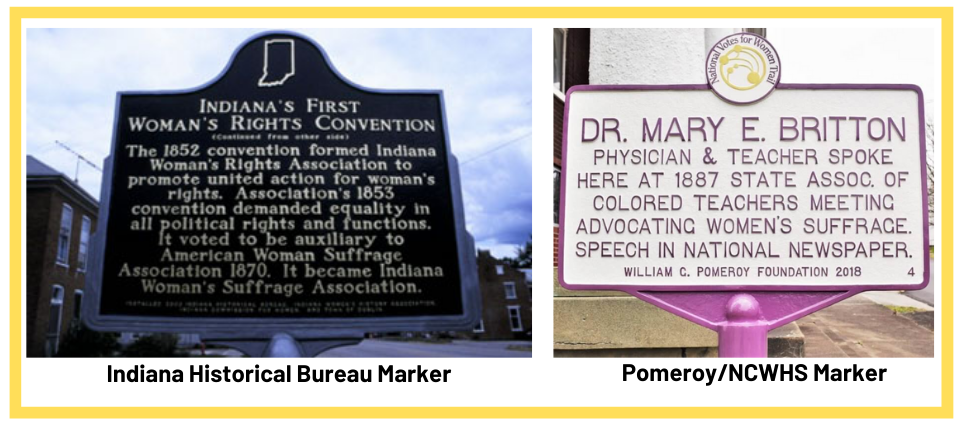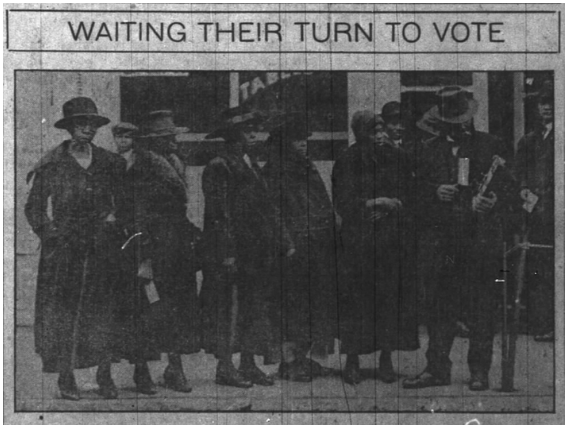
One-hundred years ago, American women won their hard-fought battle for the ballot with the ratification of the 19th Amendment. Hoosier women from diverse socioeconomic, racial, religious, and geographical backgrounds were integral to this suffrage movement. While COVID-19 has presented challenges in commemorating the centennial of women’s suffrage, we are determined that Indiana’s reformers get the recognition they deserve. After all, the suffragists taught us the value of perseverance.
Although the Indiana Historical Bureau’s historical marker application deadline recently passed, we are pleased to announce our participation in the National Women’s Suffrage Marker Grant Program. The program, founded by the National Collaborative for Women’s History Sites (NCWHS) and The William G. Pomeroy Foundation, will commemorate “places where local grassroots activity took place, thereby recognizing the remarkable efforts of the foremothers who fought to win women the right to vote which will inspire women to vote today,” according to NCWHS President Marsha Weinstein.
Where does IHB come in? IHB historian Nicole Poletika has volunteered to serve as Indiana’s state coordinator and will work with Hoosiers interested in nominating local suffragists, enfranchisement organizations, and suffrage events to be commemorated with a Pomeroy/NCWHS marker. Each state is tasked with installing one to five markers, so the process may be competitive depending on how many nominations are submitted. Indiana’s markers will be incorporated into the National Votes for Women Trail, which weaves together the work of suffragists from across the nation.
We have put together a Q&A guide in order to answer questions related to the nomination process. If you have a question that is not addressed here, please contact state coordinator Nicole Poletika at npoletika@library.in.gov. The Pomeroy Marker Toolkit is also a helpful resource.
- How do Pomeroy/NCWHS markers differ from IHB’s state historical markers?

Pomeroy/NCWHS markers provide less space than IHB markers to tell the story of the topic being commemorated. Unlike IHB markers, Pomeroy/NCWHS markers contain text on only one side. Therefore, they lend themselves to telling the stories of women who certainly deserve recognition, but perhaps less is known about their work for the movement. While applicants must raise funds for IHB markers, the cost of Pomeroy/NCWHS markers has been covered by grant funds.
2. How can I find out if a marker or plaque already exists for the topic I’m interested in?
Please see IHB’s list of women’s history markers, which have already been installed. Other databases that catalog Indiana’s historical markers include Waymarking, HMdb, and the National Votes for Women Trail. Please note that over the next five years, IHB will be commemorating these Indiana women who worked for suffrage and citizenship with historical markers.
3. Do I need to be a professional historian or researcher to submit a nomination?
No! Any interested member of the public is encouraged to submit a nomination. Indiana’s state coordinator will work with you on the application process and direct you to primary source repositories.
4. I want to nominate a topic but am not sure where to start with research. Can you point me to some resources?
Nominated topics must be accompanied by primary source documentation in order to assure accuracy of text. Typically markers require ten primary sources to verify the text, although this number can vary based on marker content. Examples of sources accepted by the grant program can be found here. While locating these sources can seem daunting, local librarians, county historians, and the grant program state coordinator are here to help! COVID-19 has made accessing primary sources more difficult, but IHB’s Research Checklist, which can be found on the “Apply for a Marker” webpage, provides you with some easily accessible free digital resources.
5. What information is required for the nomination form?
The nomination form is a fairly simple one-page document. You will be asked to provide your contact information, your proposed marker text (which must include important dates), preferred installation location and reasoning for said location, and a short paragraph explaining the significance of your topic. Nominated suffragists must demonstrate enduring engagement in the movement. Examples of nominations can be found here. Please note that the marker location cannot be so extensively altered as to destroy significance and markers must be installed where they’re easily read.

6. Who should I contact for help with the nomination process?
Email state coordinator Nicole Poletika at npoletika@library.in.gov. The Pomeroy Marker Toolkit can also guide you through the process.
7. When does my nomination form need to be submitted?
The Pomeroy Foundation has generously provided funding for a second application cycle. Nominations are now due on January 15, 2021. In addition to the nomination form, applicants must include a statement of historical significance, copies of primary sources, and the land use permission form signed by the property owners.
8. What happens once a nomination form is sent to the state coordinator?
Once the Nomination Form is completed the state coordinator will submit it to the NVWT Advisory Board for approval. The NVWT Research Team will then request primary sources and the Land Use Permission letter. The Research Team will also work with applicants and state coordinators to revise marker text or historical significance statements and add necessary primary sources. Once the nomination packet is complete, the NVWT Research Team will submit it to the Pomeroy Foundation for approval. If the Pomeroy Foundation approves the marker’s final application, the NVWT Research Team will contact the applicant and state coordinator about ordering and delivery.
9. How much do the markers cost and are applicants responsible for fundraising?
The Suffrage Marker Grant Program covers the entire cost of the historical marker, so no fundraising is necessary.
10. Do I need to get permission from owners of the selected site before installing the marker?
Yes. State coordinators, with the help of the marker applicant, will ask property owners to sign a Land Use Permission letter. If a municipality or another agency owns the land, their official letterhead will need to be added to the permission letter.
11. Who oversees installation of the marker?
It can vary, but either the state coordinator, marker applicant, community partners, or a combination of the three, will install the marker. Typically, the seven-foot pole is sunk about three feet into the ground. Most sites use concrete to provide the marker with more stability, which takes about a day to dry (similar to a fence post). The marker needs to be affixed atop of the pole and secured with the hardware provided. In some cases, someone at the site does the install themselves. In other cases, the local partner has asked the municipality’s public works department to help with install to ensure it is done appropriately. The marker weighs about fifty pounds and the pole thirty-five pounds, so two people may be needed to handle or lift the marker. Installation procedures, developed by the foundry that makes the Pomeroy markers, can be found here.

12. How can I get the word out about the marker and dedication ceremony?
Together, the state coordinator and marker applicant will promote the marker and unveiling ceremony. IHB can submit a press release, which will be delivered electronically to various local press outlets. Additionally, IHB has cultivated a considerable social media following and will promote the event on its platforms. The NVWT Research Team is also available to help with publicity, and would like to attend the unveiling ceremony, so long as they are alerted to it three weeks in advance. Pomeroy’s toolkit offers examples of press releases and tips for social media promotion.
13. I want to learn more about Indiana’s suffrage movement. What is a good primer?
While historians still have much to discover about the state’s movement, especially the contributions of African American suffragists, Dr. Anita Morgan’s “We Must Be Fearless:” The Woman Suffrage Movement in Indiana provides a nice overview. She also wrote a brief history about the movement for the Indiana Women’s Suffrage Centennial website.
Blog posts related to suffrage include:
Taking It to the Streets: Hoosier Women’s Suffrage Automobile Tour
A Silent Roar: Indiana Suffragists’ 1913 March to the Statehouse
“Suffrage Up In The Air:” The Equal Suffrage Association’s 1912 Publicity Campaign
